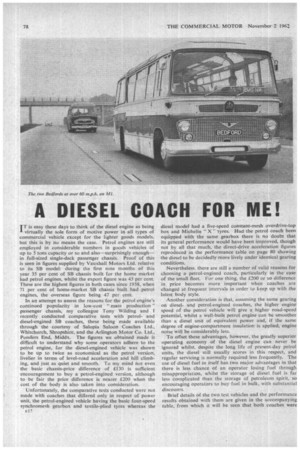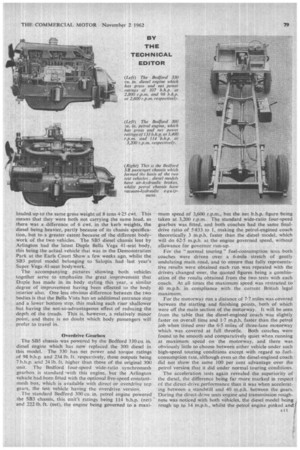A DIESEL COACH FOR ME
Page 80

Page 81

Page 82

If you've noticed an error in this article please click here to report it so we can fix it.
I T is easy these days to think of the diesel engine as being virtually the sole form of motive power in all types of commercial vehicle except for the lighter goods models, but this is by no means the case. Petrol engines are still employed in considerable numbers in goods vehicles of up to 5 tons capacity or so and also—surprisingly enough— in full-sized single-deck passenger chassis. Proof of this is seen in figures supplied by Vauxhall Motors Ltd. relative to its SB model: during the first nine months of this year 35 per cent of SB chassis built for the home market had petrol engines, whilst the export figure was 43 per cent. These are the highest figures in both cases since 1958. when 71 per cent of home-market SB chassis built had petrol engines, the overseas figure being 47 per cent.
In an attempt to assess the reasons for the petrol engine's continued popularity in low-cost 'mass production" passenger chassis, my colleague Tony Wilding and I recently conducted comparative tests with petroland diesel-engined SB coaches, these being made available through the courtesy of Salopia Saloon Coaches Ltd., Whitchurch, Shropshire, and the Arlington Motor Co. Ltd., Ponders End, Middx. The figures we obtained made it difficult to understand why some operators adhere to the petrol engine, for the diesel-engined vehicle was shown to be up to twice as economical as the petrol version, livelier in terms of level-road acceleration and hill climbing, and just as quiet and smooth. To my mind not even the basic chassis-price difference of £130 is sufficient encouragement to buy a petrol-engined version, although to be fair the price difference is nearer £200 when the cost of the body is also taken into consideration.
Unfortunately, the comparative tests conducted were not made with coaches that differed only in respect of power unit, the petrol-engined vehicle having the basic four-speed synchromesh gearbox and textile-plied tyres whereas the
diesel model had a five-speed constant-mesh overdrive-top box and Michelin "X "-tyres. Had the petrol coach been equipped with the same gearbox there is no doubt, that its general performance would have been improved, though not by all that much, the direct-drive acceleration figures reproduced in the performance table on page 80 showing the diesel to be decidedly more lively under identical gearing conditions.
Nevertheless„ there are still a number of valid reasons for choosing a petrol-engirted coach, particularly in the case of the small fleet. For one thing, the £200 or so difference in price becomes more important when coaches are changed at frequent intervals in order to keep up with the latest body style.
Another consideration is that, assuming the same gearing on dieseland petrol-engined coaches, the higher engine speed of the petrol vehicle will give a -higher road-speed potential, whilst a well-built petrol engine can be smoother than a diesel unit of equivalent power and, if the same degree of engine-compartment insulation is applied, engine noise will be considerably less.
To offset these advantages, however, the greatly superior operating economy of the diesel engine can never be ignored whilst, despite the long life of present-day petrol units, the diesel still usually scores in this respect, and regular servicing is normally required less frequently. The use of diesel fuel in itself has two major advantages in that there is less chance of an operator losing fuel through misappropriation, whilst the storage of diesel fuel is far less complicated than the storage of petroleum spirit, so encouraging operators to buy fuel in bulk, with substantial discounts.
Brief details of the two test vehicles and the performance results obtained with them are given in the accompanying table, from which it will be seen that both coaches were
loaded up to the same grossweight of 8 tons 4.25 cwt. This means that they were both not carrying the same load, as there was a difference of 6 cwt. in the kerb weights, the diesel being heavier, partly because of its chassis specification, but to a greater extent because of the different bodywork of the two vehicles. The SB5 diesel chassis lent by Arlington had the latest Duple Bella Vega 41-seat body, this being the actual vehicle that was in the Demonstration Park at the Earls Court Show a few weeks ago, whilst the SB3 petrol model belonging to Salopia had last year's Super Vega 41-seat bodywork.
The accompanying pictures showing both vehicles together serve to emphasize the great improvement that Duple has made in its body styling this year, a similar degree of improvement having been effected to the body interior also. One less obvious difference between the two .bodies is that the Bella Vista has an additional entrance step and .a lower bottom step, this making each riser shallower but having the not-so-advantageous effect of reducing the depth of the treads. This is, -however, a relatively minor point, and there is no doubt which body passengers will prefer to travel in.
Overdrive Gearbox The SB5 chassis was powered by the Bedford 330 cu. in. 'diesel engine which has now replaced the 300 diesel in this model. The 330 has net power and torque ratings of 98 b.h.p. and 234 lb. ft. respectively, these outputs being 7 b.h.p. arid 24113. ft. higher than those of the original 300 unit. The Bedford four-speed wide-ratio synchromesh gearbox is standard -with this engine, but the Arlington vehicle had been fitted with the optional five-speed constantmesh box, which is available with direct or overdrive top gears, the test vehicle having the overdrive version.
The standard Bedford 300 cu. in. petrol engine powered the SB3 chassis, this unit's ratings being 114 b.h.p. (net) and 222 lb. ft. (net), the engine being governed to a maxi
mum speed of 3,600 r.p.m., but the net b.h.p. figure being taken at 3,200 r.p.m. The standard wide-ratio four-speed gearbox was fitted, and both coaches had the same finaldrive ratio of 5-833 to 1, making the petrol-engined coach theoretically 3 m.p.h. faster than the diesel model, which will do 62.5 m.p.h. at the engine governed speed, without allowance for governor run-up. .
For the "normal touring" fuel-consumption tests both coaches were driven over a 6-mile stretch of gently undulating main road, and to ensure that fully representative results were obtained each run was repeated with the drivers changed over, the quoted figures being a combination of the results obtained from the two tests with each coach. At all times the maximum speed was restricted to 40 m.p.h. in compliance with the current British legal maximum.
For the motorway run a distance of 7.7 miles was covered between the starting and finishing points, both of which were off the main section of the motorway. It will. be seen from the table that the diesel-engined coach was slightly faster on overall time and 1.7 m.p.h. faster than the petrol job when timed over the 6.5 miles of three-lane motorway which was covered at full throttle. Both coaches were found to be smooth and comparatively quiet when running at maximum speed on the motorway, and there was obviously little to choose between either vehicle under such high-speed touring conditions except with regard to• fuelconsumption rate, although even so the diesel-engined coach did not show the same 100 per cent advantage over the petrol version that it did under normal touring conditions.
The acceleration tests again revealed the superiority of the diesel, the difference being far more marked in respect ot the direct-drive performance than it was when accelerating between a standstill and 40 m.p.h. between the gears. During the direct-drive tests engine and transmission roughness was noticed with both vehicles, the diesel model being , rough up to 14 m.p.h., whilst the petrol engine pinked and vibrated noticeably between 10 and 20 m.p.h. As with the 40 m.p.h. fuel tests, each of the two drivers drove each coach for the acceleration runs, and quoted times are based on the averages of the two sets of figures.
There was a difference of nearly one minute in favour of the diesel coach when it came to hill climbing, the performance figures of these tests being quoted in the table. Whereas bottom gear was necessary when making the climb with the petrol-engined vehicle, the driver of the diesel coach did not have to .drop below second gear, this being only marginally lower in the case of the five-speed box than it is in the four-speed box used behind the petrol engine. On the debit side, however, it must be recorded that a certain amount of black smoke was emitted by the diesel engine when pulling hard.
So far as noise is concerned, front-seat passengers in either vehicle would find cause for complaint, both being noisy.. There was little to choose between the amounts of noise penetrating the body, although my personal opinion was that the deeper note of the diesel engine was to be preferred to the more strident, higher-pitched voice of the petrol unit. Sitting in the back seat of each vehicle there was again little to choose between the amount of engine noise heard, both being very quiet, although taken generally the diesel coach was quieter because the lighter noise of the petrol engine allowed gearbox and rear-axle noise to be heard at the back of the vehicle. Based on these tests II certainly cannot agree that a standard petrol-engined coach is quieter than a standard diesel-engined model.
Taken all in all, therefore, I still remain to be convinced that there is much point these days in buying a petrolengined coach. Admittedly, some of the improved performance of the diesel-engined vehicle tested would stem from its five-speed gearbox and Michelin " X " tyres, but in favour of the petrol vehicle was the fact that it had covered 13,000 miles or so before our tests were made, whereas the diesel coach had done only 600. In terms of actual operating costs, and using figures quoted in the 1962 "Tables of Operating Costs," published by The Commercial Motor, the Bedford SB coach with petrol engine costs 5-03d. per mile for Nei, as against 2-59d. per mile in the case of the diesel. This gives respective overall running costs per mile of 1.5.72d. and 13.35d. when covering 200 miles per week, 14.37d. and 11.91d. for 400 miles per week and 13.62d. and 11.11d. for 600 mites per week. Tuppence per mile saving-is not to be sniffed at„
































































































































































